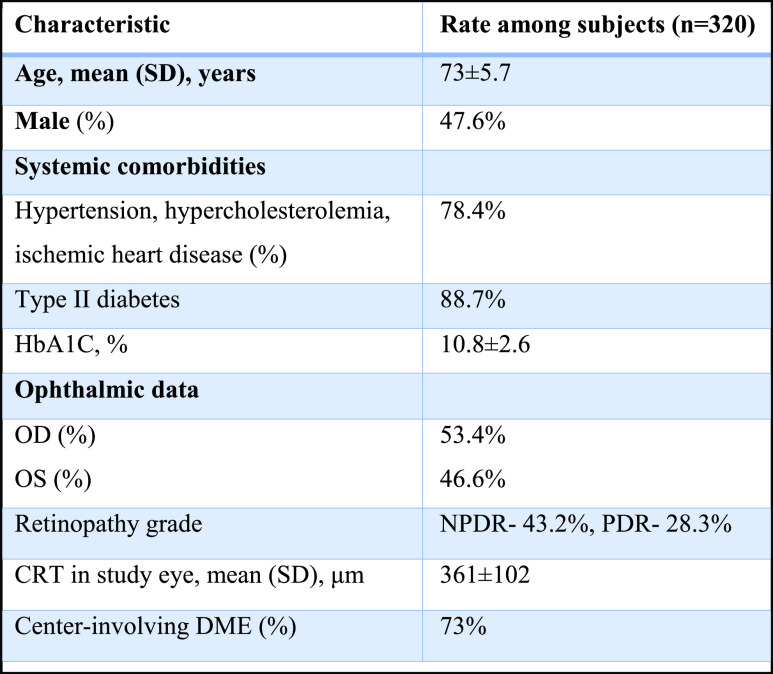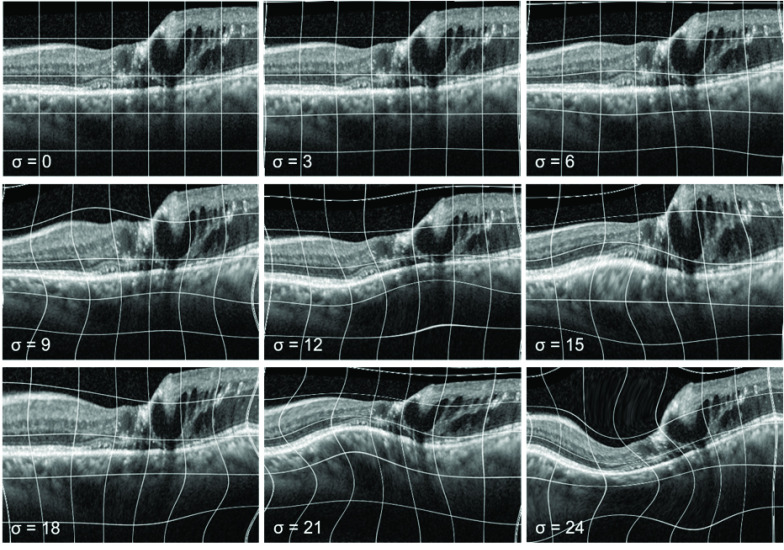用于深度学习模型训练的糖尿病黄斑水肿光学相干断层扫描图像的弹性变形:还有多远?
IF 3.7
3区 医学
Q2 ENGINEERING, BIOMEDICAL
IEEE Journal of Translational Engineering in Health and Medicine-Jtehm
Pub Date : 2023-07-24
DOI:10.1109/JTEHM.2023.3294904
引用次数: 1
摘要
-目的:探讨光学相干断层扫描(OCT)图像弹性变形用于数据增强的临床有效性,以开发检测糖尿病黄斑水肿(DME)的深度学习模型。方法:前瞻性评估经过弹性转换的DME(n=320)的OCT图像,变形强度用([公式:见正文])表示。三组图像,每组包括100对扫描(100个原始和100个修改),根据([公式:见正文])的范围进行分组,包括低、中和高增强度;([公式:见正文]=1-6)、([公式,见正文]=7-12)和([公式;见正文]=13-18)。三位视网膜专家以盲法评估了所有数据集,并将每张图像指定为“原始”和“修改”。为每个数据集中的每个分级器确定修改图像的“原始”值分配率(假阴性)。结果:低扩增类别的假阴性率在71-77%之间,中扩增类别为63-76%,高扩增类别为50-75%。原始图像的相应正确识别率在低级别的75-85%([公式:见正文]0.05)、中等级别的73-85%([公式,见正文]0.05%,3级的p=0.01)和高增强级别的81-91%([公式;见正文])之间。在子类别([公式:见正文]=7-9)中,假阴性率为93-83%,而正确识别原始图像的比率在89-99%之间(所有分级器的[公式:参见正文]0.05)。临床和转化影响声明弹性变形可以有效地增加训练数据集的大小、稳健性和多样性,而不会改变其临床价值,从而促进OCT图像自动解释的高精度算法的开发。本文章由计算机程序翻译,如有差异,请以英文原文为准。



Elastic Deformation of Optical Coherence Tomography Images of Diabetic Macular Edema for Deep-Learning Models Training: How Far to Go?
– Objective: To explore the clinical validity of elastic deformation of optical coherence tomography (OCT) images for data augmentation in the development of deep-learning model for detection of diabetic macular edema (DME). Methods: Prospective evaluation of OCT images of DME (n = 320) subject to elastic transformation, with the deformation intensity represented by (
$\sigma$
). Three sets of images, each comprising 100 pairs of scans (100 original & 100 modified), were grouped according to the range of (
$\sigma$
), including low-, medium- and high-degree of augmentation; (
$\sigma $
= 1-6), (
$\sigma $
= 7-12), and (
$\sigma $
= 13-18), respectively. Three retina specialists evaluated all datasets in a blinded manner and designated each image as ’original‘ versus ’modified‘. The rate of assignment of ’original‘ value to modified images (false-negative) was determined for each grader in each dataset. Results: The false-negative rates ranged between 71-77% for the low-, 63-76% for the medium-, and 50-75% for the high-augmentation categories. The corresponding rates of correct identification of original images ranged between 75-85% (
$\text{p}>$
0.05) in the low-, 73-85% (
$\text{p}>$
0.05 for graders 1 & 2, p = 0.01 for grader 3) in the medium-, and 81-91% (
$\text{p} < 0.005$
) in the high-augmentation categories. In the subcategory (
$\sigma $
= 7-9) the false-negative rates were 93-83%, whereas the rates of correctly identifying original images ranged between 89-99% (
$\text{p}>$
0.05 for all graders). Conclusions: Deformation of low-medium intensity (
$\sigma $
= 1-9) may be applied without compromising OCT image representativeness in DME. Clinical and Translational Impact Statement—Elastic deformation may efficiently augment the size, robustness, and diversity of training datasets without altering their clinical value, enhancing the development of high-accuracy algorithms for automated interpretation of OCT images.
求助全文
通过发布文献求助,成功后即可免费获取论文全文。
去求助
来源期刊

IEEE Journal of Translational Engineering in Health and Medicine-Jtehm
Engineering-Biomedical Engineering
CiteScore
7.40
自引率
2.90%
发文量
65
审稿时长
27 weeks
期刊介绍:
The IEEE Journal of Translational Engineering in Health and Medicine is an open access product that bridges the engineering and clinical worlds, focusing on detailed descriptions of advanced technical solutions to a clinical need along with clinical results and healthcare relevance. The journal provides a platform for state-of-the-art technology directions in the interdisciplinary field of biomedical engineering, embracing engineering, life sciences and medicine. A unique aspect of the journal is its ability to foster a collaboration between physicians and engineers for presenting broad and compelling real world technological and engineering solutions that can be implemented in the interest of improving quality of patient care and treatment outcomes, thereby reducing costs and improving efficiency. The journal provides an active forum for clinical research and relevant state-of the-art technology for members of all the IEEE societies that have an interest in biomedical engineering as well as reaching out directly to physicians and the medical community through the American Medical Association (AMA) and other clinical societies. The scope of the journal includes, but is not limited, to topics on: Medical devices, healthcare delivery systems, global healthcare initiatives, and ICT based services; Technological relevance to healthcare cost reduction; Technology affecting healthcare management, decision-making, and policy; Advanced technical work that is applied to solving specific clinical needs.
 求助内容:
求助内容: 应助结果提醒方式:
应助结果提醒方式:


